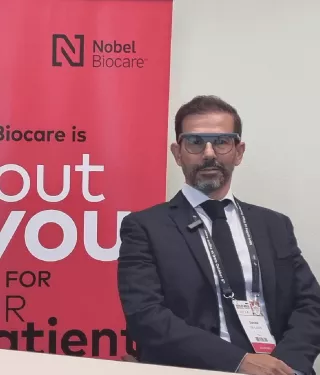
“This technique is less invasive and has a shorter healing time.”
Immediate solutions: single implant placement in posterior maxilla using NobelActive® and creos™ biomaterials
Prof. Daniele de Santis is from the University of Verona in Italy and has over 20 years of experience in the fields of oral and pre-prosthetic surgery, implant surgery, periodontology, and regenerative dentistry. With the increased patient demand for shorter time to teeth, we asked Prof. de Santis about the "dos and don’ts" of immediate implant placement in the posterior maxilla. This is one of the most challenging indications, given the anatomical structures (like the maxillary sinus and nasal floor) that can limit the ideal placement of implants. Restricted blood supply is another factor that can affect osseointegration and the healing process.
Prof. de Santis' first piece of advice to clinicians planning immediate implant placement in the posterior maxilla is to ensure proper implant positioning, which may involve utilizing angled implants, guided surgery techniques, or even bone grafting procedures if necessary. The decision to perform the sinus lift should be based on a comprehensive evaluation of the patient's anatomy through diagnostic imaging, such as CBCT scans.
Lateral sinus lift is preferred when there is insufficient bone height (<3mm) to accommodate implant placement and a wide sinus (>15mm) is present. It involves creating a lateral window in the lateral wall of the sinus, carefully elevating the sinus membrane, and placing a bone graft to augment the bone volume.
The lateral sinus lift is a more invasive procedure compared to the crestal approach, requiring a longer healing time and potentially more post-operative discomfort. On the other hand, the crestal approach has a shorter healing time than lateral sinus lift, making it a favorable option when feasible. It involves elevating the sinus membrane through a circular osteotomy created at the implant site, followed by bone grafting or placement of a shorter implant, and is suitable when there is enough residual bone height (at least 3-4mm) below the maxillary sinus and a sinus width of no more than 15mm.
Prof. de Santis uses NobelActive® implants and creos™ xenogain collagen in simultaneous sinus lift and implant placement procedures1, as:
1. NobelActive implants are designed with features that make them suitable for immediate implantation and immediate loading in situations with low-density bone, which is often encountered in the posterior maxilla.2
2. creos xenogain collagen is a xenogenic collagenated bone graft that provides excellent osteoconductive properties, promoting new bone formation and integration with the patient's existing bone.3 The block form simplifies handling and insertion during the sinus lift procedure, enhancing the stability and containment of the graft material.
References
1. Daniele De Santis, Sofia Pra, Paola Pancera, et al. Histomorphometric analysis of regenerated bone in sinus lift by deproteinized bovine bone particles. Clin Oral Impl Res. 2018 29(S17): 312.
2. Kolinski ML, Cherry JE, McAllister BS, et al. Evaluation of a variable-thread tapered implant in extraction sites with immediate temporization: a 3-year multicenter clinical study. J Periodontol. 2014 Mar;85(3):386-94.
3. Aleksic Z, Milinkovic I, Lazic Z, et al. Bone regeneration of horizontal defects in the posterior mandible: 1-year prospective study results. Clin Oral Impl Res. 2021 32(S22):147-148.